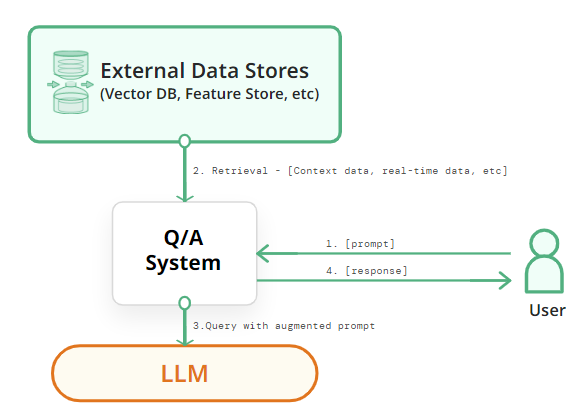Table of Contents
- Understanding Retrieval Augmented Generation (RAG)
- How RAG can be valuable for my business?
- Challenges and Considerations in Implementing RAG
- Looking Ahead: The Future of RAG in Business
In a world where artificial intelligence (AI) is transforming the business landscape, a groundbreaking development has emerged: Retrieval Augmented Generation (RAG). This innovative approach marries the capability to access vast amounts of information with the prowess of creating fresh, customized content. It offers businesses unparalleled insights and the ability to engage customers with highly personalized, relevant content, marking a significant leap towards more intelligent, data-driven decision-making and interactions. This method establishes new standards for competitiveness in our digital era.
Understanding Retrieval Augmented Generation (RAG)

Retrieval Augmented Generation is an AI methodology that fuses the retrieval of relevant information from a knowledge base with the creation of new, contextually appropriate content. The process involves two primary steps that work in harmony:
1. First, when presented with a query or a problem, the RAG system searches through a vast array of information to find data that is pertinent to the question at hand. This step is akin to finding the right ingredients for a recipe.
2. Second, after obtaining the necessary information, RAG utilizes generative AI models to synthesize it and generate responses or content that is both relevant and tailored to the original query’s context. This process involves creating something new and valuable from existing information, rather than simply repeating what is already known.
The integration of these steps results in a system capable of understanding and responding to complex queries with depth and nuance previously unattainable. It is invaluable for businesses seeking to leverage AI for enhanced decision-making, customer engagement, and content creation. This approach breaks away from traditional NLP techniques that follow a rigid recipe, by combining an advanced information lookup system with a powerful sequence-generatin mechanism. This means it doesn’t just offer answers based on programmed knowledge but actively searches for the best information to respond with. Combining the advantages of both open-book and closed-book methods.
The dual ability to retain vast amounts of learned information while continually seeking the latest data makes it highly adaptable and responsive, ideal for today’s ever-changinginformation landscape.
How RAG can be valuable for my business?
The emergence of Retrieval Augmented Generation is transforming business operations, leading to enhanced efficiency, innovation, and customer engagement. It empowers companies to make more informed decisions, provide exceptional customer service, and create content that resonates deeply with the audience’s needs. Here are some examples of how RAG can be used:
- In phygital retail, it revolutionizes customer interactions by blending online data with physical shopping experiences, offering personalized recommendations based on a shopper’s digital and in-store behavior. This enhances customer satisfaction, loyalty, and sales, reinforcing a brand’s innovative stance.
- For sustainability efforts, it navigates complex data to provide actionable insights on resource usage, environmental impacts, and compliance, improving ecological efficiency and aligning with consumer demands for responsible practices.
- In knowledge management, it streamlines the creation and sharing of organizationalknowledge, ensuring decision-makers have access to up-to-date and relevant information for strategic growth.
The technology goes beyond improving automated responses or content creation, facilitating AI systems that can research, learn, and adapt instantly. Its architecture significantly diminishes the time and resources needed for model updates, allowing for rapid adaptation to new information and maintaining a competitive edge.
Challenges and Considerations in Implementing RAG
As businesses turn to Retrieval Augmented Generation to enhance their operations and customer engagement, it is crucial to address several critical challenges during its implementation.
The most important of these is ensuring data privacy: RAG relies on extensive data to deliver its benefits, which makes it essential to have an unwavering commitment to protecting this data. This is particularly important in sectors such as healthcare and finance, where regulatory compliance is non-negotiable. To prevent breaches of sensitive information, companies must fortify their defenses with stringent data governance, encryption, and strict access controls.
Equally important is the quality of data fueling this systems. The principle of “garbage in, garbage out” holds true, underscoring the necessity for high-caliber data sources. Theaccuracy and relevance of the outputs depend on the integrity of the input data. Therefore, businesses must focus on curating rich, accurate, and timely data collections. This may involve conducting frequent data audits, adopting uniform data standards, and broadening the scope of data sources to enrich the foundation upon which RAG operates.
Another crucial factor is the reliability of RAG-generated content. Despite technological advancements, there is a risk of inaccuracies or biases influenced by the underlying data. To counter this, businesses should establish mechanisms for human oversight to review and rectify RAG outputs. Regularly refreshing RAG models with diverse, updated datasets can also dilute biases and enhance the system’s precision and fairness.
Successfully implementing RAG involves a methodical and insightful approach to navigate these challenges. A comprehensive needs analysis is conducted to identify the unique demands and limitations of your business. This leads to strategic planning and a staggered rollout to manage risks judiciously. Choosing the right technological allies like Neodata, with a solid AI pedigree, a robust stance on data protection, and sector-specific acumen, can be a game-changer. Offering indispensable insights and support throughout the deployment journey.
Looking Ahead: The Future of RAG in Business
The development of Retrieval Augmented Generation promises a future where businesses can anticipate market changes with unmatched precision. As it evolves, we can expect enhancements that narrow the gap between human and machine capabilities, especially in creativity, understanding, and personalized interactions. This evolution will enable businesses to offer innovative products and services finely tuned to customer needs.
Integrating it into daily operations could increase productivity and drive innovation, automating decisions in supply chain logistics and inspiring new products that meet consumer demands. Achieving this future requires business leaders to thoughtfully incorporate it into their digital strategies, considering ethical implications and ensuring alignment with societal values and customer expectations.
The potential for this technology in the commercial landscape is boundless, contingent on ethical and careful application. Leaders who recognize its transformative nature and integrate it into their strategies will not only reap immediate benefits but also secure long-term success in a digital, data-driven world.
AI Specialist & Data Scientist for Neodata Group
-
Manuel Sciontihttps://neodatagroup.ai/author/manuel-scionti/
